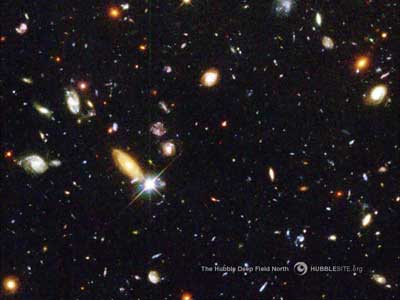The new theory, which aims to discover the sources of dark energy, proposes the existence of a new particle

Two of the biggest breakthroughs in physics in the last decade were the discovery that a group of elusive particles, called neutrinos, do have some tiny mass, and the observation that the rate of expansion of the universe is accelerating.
Now three physicists from the University of Washington claim that the two discoveries are linked through one of the universe's strangest properties, dark energy. They say that the connection may be due to an unknown subatomic particle, which they call "acceleron" (acceleron from the word acceleration).
The effects of dark energy were negligible in the primordial universe, but now dark energy makes up about 70% of the universe's content. Understanding the phenomenon may help explain the possibility that one day in the very distant future the universe will expand to such an extent that the night sky will be free of stars and galaxies. In addition, understanding dark energy will contribute to scientists' ability to determine whether the expansion of the universe will continue forever.
According to the new theory, neutrinos are affected by a new force, created as a result of interaction with accelerators. Anne Nelson (Nelson), professor of physics at the University of Washington, said that dark energy is a consequence of the universe's attempt to separate the neutrinos, which creates stretching, similar to the stretching of a rubber band. This tension fuels the expansion of the universe, she said.
Trillions of neutrinos are created in the nuclear furnaces of stars like our Sun. They move in the universe, and every second billions of them pass through any material, including people. Apart from a tiny mass, they have no electric charge, hence there is almost no interaction between them and the material through which they pass.
However, the interaction between the accelerators and the rest of the matter is even weaker, Nelson said, which is why these particles have not been detected by sophisticated detectors. However, according to the new theory, the accelerators create a force, which can affect neutrino particles. She believes that the force can be discovered in a variety of neutrino experiments, which have been running around the world for a long time.
"There are many models for dark energy, but for the most part the ways to test their correctness are limited to the field of cosmology, especially to measuring the expansion rate of the universe. "Because such measurements involve viewing very distant objects, it is difficult to make such measurements with high precision," said Nelson.
"This model is the only one that gives us some meaningful way to conduct experiments on Earth to find the force that makes dark energy exist. We can do so with the help of existing neutrino experiments.”
The new theory is presented in a paper written by Nelson, David Kaplan, also a professor of physics at the University of Washington, and Neil Weiner, a research associate in physics at the University of Washington. Their work, which received a grant from the United States Department of Energy (DOE), is detailed in an article to be published in an issue of the journal Physical Review Letters, a journal of the American Physical Society.
The researchers say that the mass of a neutrino can actually change depending on the environment through which it passes, similar to how light changes as it passes through air, water or a prism. This means that the findings of neutrino detectors depend on their location and the material around them.
If the neutrinos are a component of dark energy, the possibility of the existence of a force arises, which reconciles deviations between the various experiments, Nelson said. The existence of this force, which consists of neutrinos and accelerators, will continue to fuel the expansion of the universe, she said.
Physicists are persistently searching for evidence that can reveal to us whether the universe will continue to expand without limits or will stop at some point and collapse in on itself in the "big crunch". Although the new theory does not predict a "major collapse," Nelson said, it does predict that at some point the spread will slow down.
"In our theory, the neutrinos will eventually become so separate and massive that dark energy will no longer affect them, and the accelerated expansion of the universe will be forced to stop," she said. "The universe may continue to expand, but at a decreasing rate."
translating:
Dikla Oren
